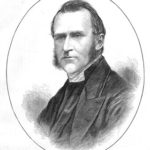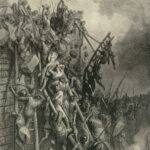Did Jesus Reveal the “Who” in “World” in John 3:14-16?
There is a lot of debate between Arminians and Calvinists about the meaning of the word, “world” in the NT, as it relates to who Christ died for. Calvinists believe that it refers only to the elect among the various people groups in the world. Arminians, on the other hand, believe that it means what it says, that it literally refers to every individual in the world, from Adam to the very last person to be born.
This disagreement has continued for hundreds of years, but I believe we have before us a unifying passage of Scripture that settles the debate. I believe Jesus Himself reveals who He is referring to when He speaks of the world in John 3:16. Before He states the beloved promise in that verse, He takes us back to the Old Testament where He makes a comparison between an incident that took place there, to the cross He would die on:
John 3:14-16:
“And as Moses lifted up the serpent in the wilderness, so must the Son of Man be lifted up, 15 that whoever believes in him may have eternal life. 16 “For God so loved the world, that he gave his only Son, that whoever believes in him should not perish but have eternal life.” (ESV)
The incident Jesus was referring to in verse 14 is found in the book of Numbers. Obviously Jesus wants us to go back and consider the account of what happened at that time. There’s a message there that we are to bring forward and apply to Christ. Once we do that we’ll be able to understand how it relates to His work upon the cross. It will give us a picture of the gospel message, and it will also reveal the extent of its outreach:
Numbers 21:4-9:
“Then they set out from Mount Hor by the way of the Red Sea, to go around the land of Edom ; and the people became impatient because of the journey. 5 The people spoke against God and Moses, “Why have you brought us up out of Egypt to die in the wilderness? For there is no food and no water, and we loathe this miserable food.” 6 The LORD sent fiery serpents among the people and they bit the people, so that many people of Israel died. 7 So the people came to Moses and said, “We have sinned, because we have spoken against the LORD and you; intercede with the LORD, that He may remove the serpents from us.” And Moses interceded for the people. 8 Then the LORD said to Moses, “Make a fiery serpent, and set it on a standard ; and it shall come about, that everyone who is bitten, when he looks at it, he will live.” 9 And Moses made a bronze serpent and set it on the standard ; and it came about, that if a serpent bit any man, when he looked to the bronze serpent, he lived.” (NASB)
Why did Jesus refer to this? Was it just because the serpent on the pole was lifted up, just like Jesus was to be lifted up on the cross? Or does it go deeper than that? No clear thinking student of God’s Word would conclude that the only reason Jesus made the comparison was simply because they were both lifted up.
Therefore let’s look at the details of what occurred:
1. The people of Israel were not happy about the way things were going.
2. They sinned by complaining against Moses and the LORD.
3. God judged the people by sending deadly serpents among them.
4. Many of the people were bit and died.
5. The people confessed their sin.
6. Moses prayed for them, and God answered by instructing him to
make a fiery serpent and to set it on a pole.
7. Those who got bit were told to look at the serpent, and if they did so,
they would live.
Those who sinned were under God’s judgment. After they confessed their sin, God provided a way of grace and mercy that would allow them to live. Note that this provision was for everyone. This provision was not for a select few, but for everyone who got bit. Furthermore, they had the freedom to either look at the serpent and live, or not to look and die. God provided the way of life, but each of them had to make it personal.
While God made the provision for all, it was up to each individual to respond in faith by looking at the serpent. I say in faith, because if they looked at the serpent, that would be a demonstration of their belief in the Word of God through Moses about the provision He made for them.
What we have in this account is a type or a picture of what Christ accomplished on the cross, and who it applies to. He wants us to look at what happened back then, and understand. Understand what? I believe He wants us to understand that provision for sin is offered to everyone, and that whoever looks upon Him in faith will live. It portrays the gospel message that we are to proclaim. As with the people of Israel, people in our world today have the freedom of choice to look upon Him and live, or not to look upon Him and die. Note the very next statement Jesus made after referring to the serpent:
“so that whoever believes will in Him have eternal life.”
I think it’s reasonable that when Jesus made that statement, He was thinking of the people of Israel who looked upon the serpent and lived. Whoever looked, lived. It’s the same today. Whoever looks upon the Son in faith, lives.
The next statement Jesus makes is in the John 3:16 verse: “For God so loved the world.”
After what we gleaned from the Numbers account, it seems fair that Jesus was defining the word “world” for us. He led right into John 3:16 with a reference to the serpent in the wilderness, which prepared us for what He was about to say next. With that preparation, it’s easy to conclude that He was revealing the who in “world,” and that the who is everyone. The provision of the cross is for all. It’s illustrated for us in Numbers in a way that should leave no doubt in anyone‘s mind.
Jesus said, “As Moses lifted up the serpent in the wilderness, so must the Son of Man be lifted up.”
“As Moses lifted up”…..In other words, in the same way, according to the same way of life that we see in that Numbers passage.
Again, the idea that Jesus was merely making a reference to the fact that both were being lifted up, really serves little purpose if the meaning stops there. The plan of salvation is so vivid in that Numbers passage of Scripture, that it’s myopic to suggest that this is not what Jesus wanted us to see. It was salvation that He was discussing with Nicodemus, and it’s a picture of salvation that we see in Numbers. Furthermore, within that picture is the provision of salvation to all sinners. Numbers interprets “world” as everyone.
This interpretation is both reasonable and responsible. There is no agenda, there is no position to protect or to support. We have not tried to make Scripture mean anything other than what it is actually saying. All we did here was make an observation about the events in Numbers, and then applied them to Jesus and the cross, as He certainly wanted us to do.
In my opinion, the only way we can come to any other conclusion about who Jesus had in mind when He referred to the “world”, and who the provision of the cross is available to, is if we approach these texts with a positional bias. If we approach any passage with a bias, we will not be able to see clearly what is in front of us. We normally end up having to force a meaning into it in order to get it to conform to our position. If we find ourselves having to do that with a large number of passages, that should put us on the alert that perhaps the position we hold to isn’t the right one. We must allow God’s Word to mean what it’s actually saying, and in this case, we must listen carefully to what Jesus Himself is saying, within the context of the Numbers passage.
The Gospel According To Numbers
The plan of salvation in our Numbers 21 passage is clearly depicted, and mirrors what we have in the New Testament. It provides an outline that is much like what we use today when sharing the gospel message with someone. I thought seeing it like this would help to enforce what we learned above:
1. As sinners we deserve judgment (vs. 6)
2. God is merciful and provides salvation (vs. 8,9)
3. The serpent was lifted up as the means (vs. 8,9)
4. We must confess and repent of our sins (vs. 7)
5. Provision of life is offered to all (vs. 8)
6. Life is not given automatically, but through individual faith (vs. 8,9)
7. Each person has the freedom to receive or reject God’s offer of
Salvation (vs. 8,9)
If this is not a picture of the gospel of Jesus Christ, and if this picture does not indicate an offer to all sinners of the world, and if this is not what Jesus wanted us to see, what then?






Leave a Reply